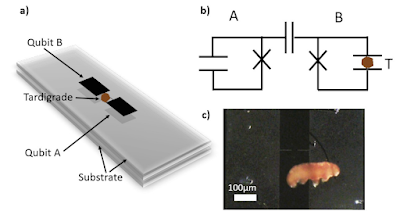in which we first showed that the quantum state of the graviton field outside the black hole is determined by the quantum state of the interior.
The new paper describes Hawking evaporation of a black hole taking into account the quantum state of the exterior geometry.
After the first quantum hair paper appeared, I wrote a long post (November 14 2021) describing Hawking's black hole information paradox, which I excerpt from below.
In 1976 Stephen Hawking argued that black holes cause pure states to evolve into mixed states. Put another way, quantum information that falls into a black hole does not escape in the form of radiation. Rather, it vanishes completely from our universe, thereby violating a fundamental property of quantum mechanics called unitarity.
These are bold statements, and they were not widely understood for decades. As a graduate student at Berkeley in the late 1980s, I tried to read Hawking’s papers on this subject, failed to understand them, and failed to find any postdocs or professors in the particle theory group who could explain them to me.
As recounted in Lenny Susskind’s book
The Black Hole War: My Battle with Stephen Hawking to Make the World Safe for Quantum Mechanics, he and Gerard ‘t Hooft began to appreciate the importance of black hole information in the early 1980s, mainly due to interactions with Hawking himself. In the subsequent decade they were among a very small number of theorists who worked seriously on the problem. I myself became interested in the topic after hearing a talk by John Preskill at Caltech around 1992:
Do Black Holes Destroy Information?
https://arxiv.org/abs/hep-th/9209058
John Preskill
I review the information loss paradox that was first formulated by Hawking, and discuss possible ways of resolving it. All proposed solutions have serious drawbacks. I conclude that the information loss paradox may well presage a revolution in fundamental physics.
Hawking’s arguments were based on the specific properties of black hole radiation (so-called Hawking radiation) that he himself had deduced. His calculations assumed a semiclassical spacetime background -- they did not treat spacetime itself in a quantum mechanical way, because this would require a theory of quantum gravity.
Hawking’s formulation has been refined over several decades.
Hawking (~1976): BH radiation, calculated in a semiclassical spacetime background, is thermal and is in a mixed state. It therefore cannot encode the pure state quantum information behind the horizon.
No Cloning (~1990): There exist spacelike surfaces which intersect both the interior of the BH and the emitted Hawking radiation. The No Cloning theorem implies that the quantum state of the interior cannot be reproduced in the outgoing radiation.
Entanglement Monogamy (~2010): Hawking modes are highly entangled with interior modes near the horizon, and therefore cannot purify the (late time) radiation state of an old black hole.
However, reliance on a semiclassical spacetime background undermines all of these formulations of the BH information paradox, as I explain below. That is, there is in fact no satisfactory argument for the paradox.
An argument for the information paradox must show that a BH evaporates into a mixed final state, even if the initial state was pure. However, the Hilbert space of the final states is extremely large: its dimensionality grows as the exponential of the BH surface area in Planck units. Furthermore the final state is a superposition of many possible quantum spacetimes and corresponding radiation states: it is described by a wavefunction of the form ψ[g,M] where g describes the spacetime geometry and M the radiation/matter fields.
It is easy to understand why the Hilbert space of [g,M] contains many possible spacetime geometries. The entire BH rest mass is eventually converted into radiation by the evaporation process. Fluctuations in the momenta of these radiation quanta can easily give the BH a center of mass velocity which varies over the long evaporation time. The final spread in location of the BH is of order the initial mass squared, so much larger than its Schwarzschild radius. Each radiation pattern corresponds to a complex recoil trajectory of the BH itself, and the resulting gravitational fields are macroscopically distinct spacetimes.
Restriction to a
specific semiclassical background metric is a restriction to a very small subset X of the final state Hilbert space Y.
Concentration of measure results show that for almost all pure states in a large Hilbert space Y, the density matrix
ρ(X) = tr ψ*ψ
describing (small) region X will be exponentially close to thermal -- i.e., like the radiation found in Hawking's original calculation.
Analysis restricted to a specific spacetime background is only sensitive to the subset X of Hilbert space consistent with that semiclassical description. The analysis only probes the mixed state ρ(X) and not the (possibly) pure state which lives in the large Hilbert space Y. Thus even if the BH evaporation is entirely unitary, resulting in a pure final state ψ[g,M] in Y, it might appear to violate unitarity because the analysis is restricted to X and hence investigates the mixed state ρ(X). Entanglement between different X and X' -- equivalently, between different branches of the wavefunction ψ[g,M] -- has been neglected, although even exponentially small correlations between these branches may be sufficient to unitarize the result.
These and related issues are discussed in
1.
arXiv:0903.2258 Measurements meant to test BH unitarity must have sensitivity to detect multiple Everett branches
BH evaporation leads to macroscopic superposition states; why this invalidates No Cloning and Entanglement Monogamy constructions, etc. Unitary evaporation does not imply unitarity on each semiclassical spacetime background.
When Hawking's paradox first received wide attention it was understood that the approximation of fixed spacetime background would receive quantum gravitational corrections, but it was assumed that these were small for most of the evaporation of a large BH. What was not appreciated (until the last decade or so) is that if spacetime geometry is treated quantum mechanically the Hilbert space within which the analysis must take place becomes much much larger and entanglement between X and X' supspaces which represent distinct geometries must be considered. In the "quantum hair" results it can be seen very explicitly that the evaporation process leads to entanglement between the radiation state, the background geometry, and the internal state of the hole. Within the large Hilbert space Y, exponentially small correlations (deviations from Hawking's original semiclassical approximation) can, at least in principle, unitarize BH evaporation.
In summary, my opinion for the past decade or so has been: theoretical arguments claiming to demonstrate that black holes cause pure states to evolve into mixed states have major flaws.
This recent review article gives an excellent overview of the current situation:
Lessons from the Information Paradox
https://arxiv.org/abs/2012.05770
Suvrat Raju
Abstract: We review recent progress on the information paradox. We explain why
exponentially small correlations in the radiation emitted by a black hole are sufficient to
resolve the original paradox put forward by Hawking. We then describe a refinement of
the paradox that makes essential reference to the black-hole interior. This analysis leads
to a broadly-applicable physical principle: in a theory of quantum gravity, a copy of all
the information on a Cauchy slice is also available near the boundary of the slice. This
principle can be made precise and established — under weak assumptions, and using
only low-energy techniques — in asymptotically global AdS and in four dimensional
asymptotically flat spacetime. When applied to black holes, this principle tells us
that the exterior of the black hole always retains a complete copy of the information
in the interior. We show that accounting for this redundancy provides a resolution
of the information paradox for evaporating black holes ...
Raju and collaborators have made important contributions demonstrating that in quantum gravity information is never localized -- the information on a specific Cauchy slice is recoverable in the asymptotic region near the boundary. [
1] [
2] [
3]
However, despite the growing perception that the information paradox might be resolved, the mechanism by which quantum information inside the horizon is encoded in the outgoing Hawking radiation has yet to be understood.
In a
recent paper, my collaborators and I showed that the
quantum state of the graviton field outside the horizon depends on the state of the interior.
No-hair theorems in general relativity severely limit the information that can be encoded in the
classical gravitational field of a black hole, but we show that this does not hold at the quantum level.
Our result is directly connected to Raju et al.'s demonstration that the interior information is recoverable at the boundary: both originate, roughly speaking, from the Gauss Law constraint in quantization of gravity. It provides a mechanism ("quantum hair") by which the quantum information inside the hole can be encoded in ψ[g,M].
##########################









